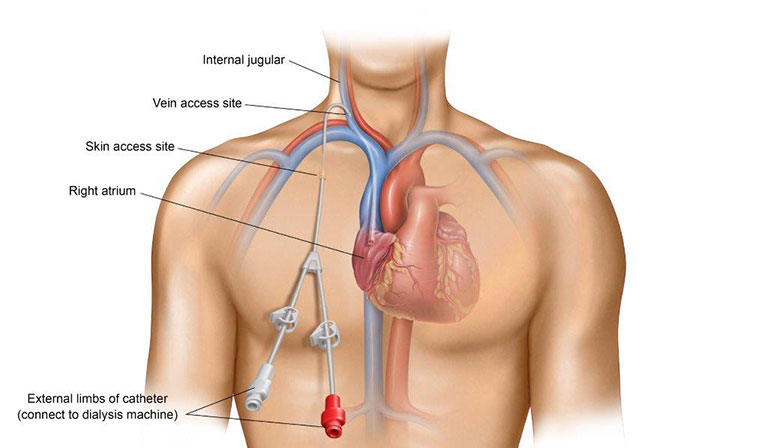
There are many different types of catheters and lines utilized by medical professionals to access your blood, whether used for taking blood samples, administering medication or receiving dialysis. You’re probably already familiar with a standard IV, or peripheral IV, that’s usually placed in the hand or arm, but there are other types of access as well, such as a central venous catheter (CVC) and a peripherally inserted central venous catheter (PICC).
A CVC serves as a way to access your blood and helps your medical team deliver medication, blood products, nutrients, or fluids directly into your bloodstream or to draw blood samples. A peripherally inserted central catheter, also known as a PICC (pronounced “pick”), is just one type of central venous catheter. While a PICC is never used for dialysis, it is commonly used to administer medications for patients, such as antibiotics or chemotherapy.
Let’s look at the similarities and differences between a CVC and a PICC, and when you might come across them in your care.
Central Venous Catheters (CVC)

What is a CVC?
A central venous catheter is a long, flexible, y-shaped tube that is inserted through one of the central veins found in your neck, chest or groin to allow access to the bloodstream. A CVC is much longer than the standard IV and is placed deeper in the body into larger blood veins. The CVC is also able to remain in the body for a longer period of time than the standard IV.
There are two types of central venous catheters: tunneled and non-tunneled. Tunneled CVC’s are placed under the skin and meant to be used for a longer duration of time. Non-tunneled catheters are designed to be temporary and may be put into a large vein near your neck, chest, or groin.
During an outpatient procedure, a physician who specializes in vascular access makes a small incision in the skin over the selected vein located in the neck, upper chest, or groin. The physician will numb the area for the insertion and may use x-ray imaging to guide the catheter into its correct location downward toward the chest.
After it’s inserted, two soft tubes will be visible on the outside of the body in the upper chest area. These tubes will serve as access to the bloodstream and will be capped off when not in use. The internal portion of the CVC (the tip) rests in the right upper chamber of the heart and the y-end of the CVC remains outside of your body.
What is a CVC Used For?
A CVC can be accessed for a multitude of uses, including administering medicine, nutrition or chemotherapy, drawing blood, or receiving dialysis treatment. (i)
Why Would I Need a CVC?
If you are receiving long-term treatment, whether it’s for an infection or cancer, a CVC provides easy access to your blood for medical providers.
A CVC is also an option for hemodialysis treatment. It’s important to note that while a CVC can be used for dialysis, an arteriovenous (AV) fistula is considered the first and best choice in dialysis access. In some cases, a central venous catheter may be placed for urgent hemodialysis while the patient’s AV fistula is still healing and/or maturing. It takes several months for an AV fistula to be ready for dialysis use, but a CVC can be used as soon as its placed. If for some reason a patient can’t have an AV fistula or AV graft created, such as small or scarred veins, a CVC might be utilized as the primary dialysis access.
The Advantages of a CVC
- Immediate access: A CVC can be used as soon as it is placed, so it’s a good choice if urgent or emergent dialysis is needed.
- Long-term access: A CVC can remain in place for days, weeks, and even months, so it’s useful for patients undergoing long-term treatment.
- No needles: No needles are required for access, whether you are receiving medicine with your CVC or utilizing it for dialysis treatment. The tubes from the catheter connect directly to IV tubing or the tubes on the dialysis machine. Blood can also be drawn from the CVC, negating the need for needles during routine or recurring blood tests.
The Disadvantages of a CVC
- Serious infection from CVC: Infections can be localized (to the area of the insertion site) or systemic (affecting the whole body). Infection is responsible for the removal of about 30%–60% of CVCs and hospitalization rates are higher in CVC patients than patients with other types of dialysis accesses. The most dangerous infectious complication is catheter-related bloodstream infection (CRBSI), associated with high rates of morbidity and mortality. (ii)
- Risk of Clots: Blood clots can form on and/or in the internal opening of the catheter and slow or entirely block the blood flow. When this occurs, the clots need to be dissolved, usually with a type of medicine, before care can continue.
- Damage to Blood Vessels: Over time, a CVC can cause a stenosis, or narrowing, of the vein(s) where it’s placed. This can cause damage to the walls of the vein and may prevent blood from flowing adequately.
Peripherally-Inserted Central Catheters (PICC)
What is a PICC?
A PICC is a type of central catheter. It also consists of a long, soft tube called a catheter, but a PICC is placed in the upper arm as opposed to the neck, chest, or groin. The catheter is introduced into a small, superficial vein in your arm and is threaded proximally until its tip ends in the largest vein of the body near your heart.
A PICC can be easily placed in an outpatient setting. A vascular specialist will first use ultrasound to visualize the superficial veins in your upper arm. Once your arm is cleaned and covered with a sterile cloth, medicine is used to numb the area where the PICC will be inserted. The tip of the catheter will then be guided to the large vein near your heart, and once in place, it will be held to your arm with special tape and sterile dressing. Most patients feel little to no discomfort during this minimally-invasive procedure. (iii)
What is a PICC used for?
Because it can be left in place for weeks or months at a time, a PICC is commonly used in patients who need an extended course of medications. A PICC may also be used for certain types of chemotherapy. (iii)
Due to the smaller size and lower volume flow, a PICC is never used for receiving dialysis treatment.
Why Would I Need a PICC?
Often when you need medicine, you can simply pop a pill in your mouth. But if you need long-term antibiotics, chemotherapy or other types of medication that are administered through your veins, a PICC may be a better option.
Repeated needle sticks can take a toll on patients. When you receive standard IVs and needle sticks over and over again, it can cause damage to the veins in your arm. This repeated process can lead to scarring over time and also make the veins difficult to access in the future. Additionally, some medications can irritate the smaller veins of the hand, so a PICC may bring more patient satisfaction during treatments. (iii)
What are the Advantages of a PICC?
- No Needles: A PICC can spare your veins multiple needle sticks needing for giving medications or drawing blood, improving overall patient satisfaction.
- More comfortable: Sometimes, certain medications or chemotherapies can have irritating effects when administered through a traditional IV. A PICC line spares your veins from this effect during treatment. (iii)
What are the Disadvantages of a PICC?
- Risk of Infection: Like any line or device introduced into the skin, a risk of infection can occur if the area isn’t kept clean.
- Malfunction: A PICC can move out of position in the vein if not well-secured or completely covered and may need to be repositioned or removed. A blood clot can also form which may need medication to clear it. (iii)
Is a CVC or PICC right for me?
Understanding the differences between a CVC and PICC as well as other types of catheters can be an intimidating part of your care. It’s important to work with your medical team to understand all the benefits and risks of CVCs and PICCs and which type is best for you. Remember, both CVCs and PICCs can be used for administering medicine and drawing blood, but only a CVC can be used for dialysis treatment.
Sources:
(i) Cleveland Clinic. (July 30, 2015) Peripherally Inserted Central Catheter (PICC): Procedure Details. Retrieved on September 10, 2019 from https://my.clevelandclinic.org/health/treatments/14983-peripherally-inserted-central-catheter-picc/procedure-details.
(ii) Santoro, D., Benedetto, F., Mondello, P., Pipitò, N., Barillà, D., Spinelli, F., … Buemi, M. (2014). Vascular access for hemodialysis: current perspectives. International journal of nephrology and renovascular disease, 7, 281–294. doi:10.2147/IJNRD.S46643
(iii) The Kidney Foundation of Canada. Some facts about central venous catheters (hemodialysis catheters). (n.d.) Retrieved on September 10, 2019 from https://www.kidney.ca/document.doc?id=764.


